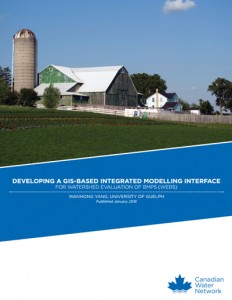Developing an Open Source GIS-based Integrated Modeling Interface for Watershed Evaluation of BMPs
Principal Investigator - Wanhong Yang, Professor, University of Guelph (2013-2014)

Challenge
As it stands, on-farm models and watershed hydrologic models are very complex and are not user-friendly for practitioners as related to their conservation management operations. An opportunity exists to develop user-friendly tools to make scientific knowledge in these modeling systems accessible to conservation managers and decision makers for determining areas of greatest risk for sediment and nutrient loadings to surface water and prioritizing Best Management Practices (BMPs) for implementation in agricultural watersheds. This project proposes to develop a Geographic Information System (GIS)-based integrated modeling interface to evaluate BMPs in the Gully Creek watershed to address this opportunity. As the two initial projects from which this study extends ended in March 2013, this study is opportunely timed. The Ausable Bayfield Conservation Authority (ABCA) and other partners including Ontario Ministry of Agriculture and Food and Ministry of Rural Affairs, Ontario Ministry of the Environment, and Conservation Ontario have expressed great interest in a GIS-based tool, and will participate in its design and application.
The proposed study builds upon the following initial projects:
Project 1 (2005-2012) – Hydrologic and Integrated Modeling of South Tobacco Creek Watershed in Southern Manitoba, Dr. Wanhong Yang, University of Guelph.
The project was funded through Agriculture and Agri-Food Canada’s WEBs (Watershed Evaluation of Beneficial Management Practices or BMPs) program. This work occurred in three phases: from 2005 to 2008, research focused on adapting the Soil and Watershed Assessment Tool (SWAT) hydrologic model to Canadian conditions and developing BMP modules; from 2009 to 2011, research manually ran the SWAT and on-farm economic models, combining model outputs to examine the cost effectiveness of BMP scenarios; finally, from 2012 to 2013, research focused on developing an interactive system to link these two models.
Project 2 (2011-2013) – Modeling for Evaluating the Economic and Environmental Effects of Multiple BMPs in Gully Creek Watershed in Southwestern Ontario, Dr. Wanhong Yang, University of Guelph.
The project was funded through Ontario Ministry of Agriculture, Food, and Rural Affairs’ WBBE (Watershed Based BMP Evaluation) Program. In the project, the SWAT was adapted to simulate water quantity and quality effects of multiple BMPs. On-farm economic models were also developed to estimate economic costs of these BMPs. Model outputs were combined manually to examine cost effectiveness, since the integrated modeling system was not yet developed.
Project
This project will focus on adapting and improving the structural design and utility of the existing modeling interface. As the Gully Creek study watershed is in a distinct geographical region and has a different set of BMPs than the previously studied South Tobacco Creek Watershed, a new set of BMP modules and related functions will be developed for the GIS interface.
The first stage of the project will involve developing key components of the interface, including database construction, scenario design, modeling execution, and output visualization. Modules will then be developed in sequence for four representative BMPs – water and sediment control basin, conservation tillage, nutrient management, and cover crop. In this way, users will have the opportunity to test the interface for individual BMPs.
Regular meetings will be held to update interface development and seek end user input. In project planning, interim testing of the interface will be arranged. Through their involvement in the development process, end users will be able to gradually master the interface for management purposes. At the end of the project, a provincial workshop will be organized to showcase the interface to a wide range of stakeholders, including conservation authorities and government agencies.
The proposed interface development will build on knowledge gained from the integrated modeling development of Project 1 in Manitoba and transfer this knowledge to the Ontario-based project site, which has distinct geographic characteristics and BMP types.
Outputs
Anticipated Outputs include:
- Development of an integrated modeling system based on established SWAT and on-farm economic models
- Further development of the integrated modeling system into a user-friendly interface based on free and open source GIS
Outcomes
Anticipated Outcomes Include:
- Increased understanding of economic and environmental processes in agricultural landscapes
- Increased accessibility of complex models for conservation managers and decision makers
- Build on knowledge gained from the integrated modeling development of Project 1 in Manitoba




